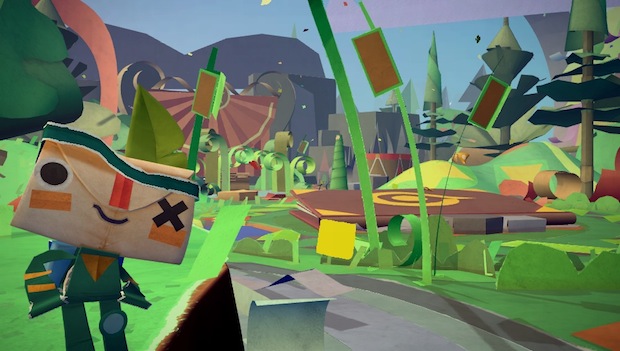I had the pleasure of speaking with Media Molecule’s Technical Director, Alex Evans, and Creative Director, Rex Crowle, about their newly revealed Vita title, Tearaway. Some are already calling the title the PlayStation Vita’s savior, but I don’t think that Media Molecule is thinking that hard about it. These guys just had a great idea for a game and went nuts with it.
In Tearaway you play as a envelope-headed messenger named Iota, out on an a adventure to deliver a very special message.
Iota lives in a world made entirely of paper, and you serve as the god of that world. You’ll interact with this world to influence Iota’s journey to deliver his message through the Vita’s unique input options. For example, your fingers can reach into the game’s world by using the rear touch panel to push around platforms. Blowing into the microphone might let you stir up some wind, and the gyrosensors could let you tilt the world around.
Media Molecule told us that the Vita and its various input methods served as the starting point for Tearaway, and that the rest just seemed to fall into place after that.
“The first starting point was as soon as I learned about the back touch; I wanted to put my fingers into the game and, you know, we’ve never seen that before,” Crowle explained. “And then we started building a world around that, and obviously it makes sense for that world to be fragile, and then the paper stuff came though.”
Going into further detail on the use of paper for the game’s world, Crowle continued: “If you’re going to push into a world it makes sense that you would have a material that could kind of accept your input. And then, from there, we built up more of a world, and then it was really time to go onto a bit of a game jam to try to think of other stuff.”

The core idea for Tearaway was so good that it snowballed into a project so big that the development team had to stop themselves to get back on track. Technical Director Alex Evans said that they’ve been working on this title for about a year now, but they had to refocus the project a few months back.
“We were too busy smoking our own dope,” said Evans. “In every game studio and every team I’ve ever worked on there’s a moment kind of a bit before alpha where you just lose sight of what you’re making and suddenly you’re making nine games instead of one game.”
“Rex is the creative director and he had this thing in his head from day one that was, like, it’s a Vita game and it’s going to use the features and it’ll be in this big adventure context. But somehow we were kind of busy building worlds and we kind of lost sight of the Vita-ness of it.”
Crowle: “And I think that’s design as well. Often it’s more about what you delete than what you create. It’s very easy to create a thousand ideas but it’s working out which one is the good one. We’ve got a lot of mad concepts to take people through as well with the character and the message.”

A primary focus for Tearaway is to have the world around the player slowly intersect with the game’s world. Everything from the way players will interact with the game to visual cues they’ll come across will work toward this goal, and it will all tie into the final message that Iota delivers at game’s end.
“The whole game is just truing to be this complete mashup of the world that’s kind of in here and then the world all around,” Crowle explained. “As you get more through the game we’ll show more of the real world — the world around us — sort of seeping into the game.”
They handed me a Vita and encouraged me to press up on the rear touch panel with my fingers. What looked like my fingertips popped through the paper background of a stage, knocking some on-screen enemies around, with one flying directly into the screen’s face. They pointed out that through live video feed from the rear camera, I could see the environment below the Vita around the holes made with my fingertips.

“It’s like an augmented reality remix of the whole ‘the way you play affects the game’ thing,” said Evans. “The Tearaway version of it is like using what textures you have around you. We can capture loads of ambient stuff without you even knowing it, and that’s why the message is unique at the end of the game. You get this message, and that’s the big mystery, the big reveal will be what was inside his [Iota’s] head. That’s the motivation to finish it.”
“There’s a section where you can see where you can actually capture your own texture. We love this loop where its creative gaming without being the heavy handed user-generated content thing. You can just retexture the elk with your stupid shirt or your analog synth or whatever it is you want to do.”
Evans continued, “There’s like sequences that are more like hardcore platforming for that audience, for people that want really want to time trial it. Speed runs and stuff. And then there’s this sort of — the Media Molecule thing of trying to make it unthreatening in the visual style, so there’s a bigger audience that will come to it.

I asked them if they would be offended if some viewed Tearaway as a Vita interface showcase. Surprisingly, they were fine with the label, though they were clear in that this is a full game, and not a collection of minigames.
Evans: “I love the fact that people are picking up on that. It started as a small game and grew up into a big one, and that’s how I’d like it to be seen.”
Crowle: “The game is a full length — it’s not a mini game game. It will be a rich world in where you will have a good focus to bring you all the way through it. It’s full of characters to help out and situations to deal with. It’s not progressing trough screen after screen of platforming. It’s a world, but it has focus points.”
“That’s one of the things we’ve been balancing a lot. We had a massive open world section we called the Wilderness and it was interesting because you met different characters, but then we found you needed a balance between that and more directed segments where you felt like you had a mission. It’s that balance that we’re hoping we show the next time we’re out. At the moment it’s much more like [a] reveal. Next time we’ll be able to show more of the structure of how it goes.”
“I love the reception so far. It’s really inspiring to get that feedback,” said Evans.
“We’ve been working on it for just over a year. We didn’t know when the right moment was to announce it and…how do you introduce a game like this, that’s early still?”
“The team back home is going to be coding double speed now just because of the vibe.”


